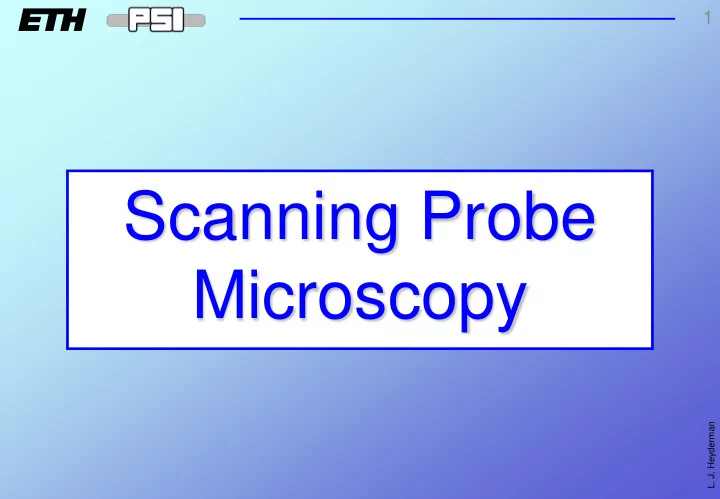

1 Scanning Probe Microscopy L. J. Heyderman
2 Scanning Probe Microscopy If an atom was as large as a ping-pong ball... ...the tip would have the size of the L. J. Heyderman Matterhorn!
3 Magnetic Force Microscopy • Stray field interaction between film and magnetic tip • Forces are on the order of 10 -10 N • Employ a cantilever (CL) "spring" • The force sensing carried out in two ways: • Static force sensing: CL brought near to surface and bends down or up (interaction attractive or repulsive). But CL might "snap" onto the surface. L. J. Heyderman • Dynamic force sensing: CL is oscillated at a certain frequency, typically at its resonance frequency or a bit off (5%)
4 Non Contact Dynamic MFM Laser S chematic drawing: Oscillation piezo Cantilever M Magnetic tip Sample XYZ scan piezo The cantilever is oscillated with a fixed amplitude (nm). The sample is scanned by the XYZ scan piezo. The measurement signal is the frequency shift ( shift of L. J. Heyderman cantilever‘ s resonance frequency), measured with a quadrant diode detector or laser interferometer. Peter Kappenberger, Hans Hug
5 SFM Dynamic Operation Modes Measurement S ignal: Massless spring system harmonic oscillator spring 1 c constant 0 = L f Freq. π 2 m mass Cantilever z Tip-sample interaction Linear part of Taylor Expansion ∂ ∂ ∂ f F F int eract ion force 1 1 F δ ≡ − ≈ − = − 0 f f f f c ∂ ∂ π ∂ P 0 P L gradient 2 c z z 2 m z L L. J. Heyderman At t ract ive forces lower resonance frequency -ve freq. shift Repulsive forces higher resonance frequency +ve freq. shift Peter Kappenberger, Hans Hug
6 The High Resolution MFM Rack with control electronics: L. J. Heyderman Peter Kappenberger, Hans Hug
7 High Resolution MFM: Requirements • High aspect ratio tip with small apex diameter, small cone angle. • Ultra-thin & smooth ferromagnetic coating (3-6 nm). • High measurement sensitivity limited only by thermal noise of cantilever due to gas molecules hitting cantilever. Therefore need to go to vacuum (results in a large Q, i.e. a low damping). Apex Diam. 10nm >10µm L. J. Heyderman Peter Kappenberger, Hans Hug T .R. Abrecht, J. Appl. Phys. 69 (2), p668 (1994)
8 High Resolution MFM: Example High resolution MFM images of hard disk media (sample by S eagate Research) : Bits organised in circumferential tracks: Increasing density / decreasing bit size hr-MFM images important in HD research: L. J. Heyderman - detect defects in the bits - measure media properties Peter Kappenberger, Hans Hug A. Moser et al. J. Magn. Magn. Mater. (2005)
9 In-Plane Structures with CNT Tip Y. Lisunova, J. Heidler, I. Levkivskyi, I. Gaponenko, A. Weber, Ch. Caillier, L.J. Heyderman, M. Kläui and P. Paruch Nanotechnology (2013) High resolution with no vacuum! Scale Bar: 100 nm Commercial CNT L. J. Heyderman
10 Magnetic Islands with EUV-IL Co/Pd Multilayer on SiO x Pillars Period = 50 nm 263 Gbit/in 2 Diameter = 28.4 nm, σ = 5 % H = -6.5 kOe -7 kOe MFM measurements Switched Islands: Mean switching field: 7200 Oe SFD ( σ /mean) = 11.5 % L. J. Heyderman 100 nm F. Luo, L. J. Heyderman, H. H. Solak, T.Thomson, M. E. Best APL (2008)
11 CoPt Multilayer in Hysteresis Loop Magnetization of layers from top to bottom. L. J. Heyderman Which grey level corresponds to which layer? Take a calibrated tip and compare simulation with image. Peter Kappenberger, Hans Hug
12 Simulation of MFM Images 1 2 Colours: Guess domains in different layers 3 L. J. Heyderman Peter Kappenberger, Hans Hug
13 Topography Separation Magnetic contrast inverts when rotating the tip magnetization by 180° . Topographic contrast remains (van der Waals is always attractive). Acquire two images with opposite tip magnetization states. A B Tip magnetization up Tip magnetization down A B A-B A+B For remagnetizing the tip, a field of ~1T is required! If sample has a lower switching field, need to separate tip and sample macroscopically. L. J. Heyderman Problem in finding the exact x,y,z position again. Peter Kappenberger, Hans Hug
14 MFM Summary • Maps the magnetic stray field (or derivative) • Resolution: typically 20-30 nm, high resolution: 10 nm • Non-destructive • Especially sensitive to z-component of stray field: ideal for perpendicular anisotropy materials (e.g.magnetic media) but can also image domain walls in in-plane samples • Requires virtually no sample preparation • Surface should be relatively flat • Tip quality is critical L. J. Heyderman • Influence of tip: difficult to measure magnetically soft samples
Recommend
More recommend